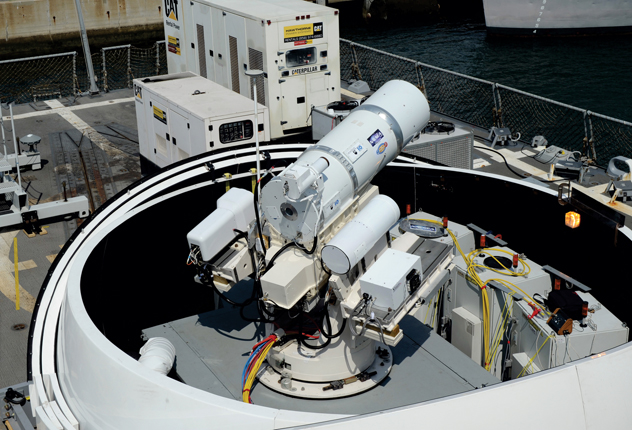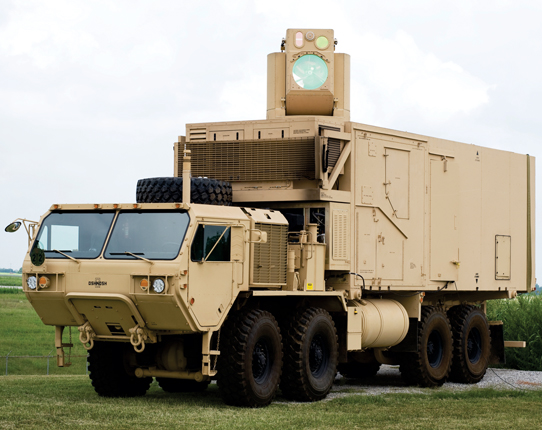Lasers will shine in future warfare
DOI: 10.1063/PT.3.2443
Later this year the US Navy will deploy a laser weapon aboard a ship in the Persian Gulf. Slated to be installed on the USS Ponce, an amphibious transport dock, the laser weapon system will be capable of shooting down the unmanned aerial vehicles (UAVs) and disabling the small attack boats that officials say are rapidly increasing threats.
“This is a revolutionary capability,” Matthew Klunder, chief of naval research, said in a statement. “This very affordable technology is going to change the way we fight and save lives.”
The 30-kW weapon system is a prototype that bundles six commercial fiber lasers. Their noncoherent beams converge at the target, which they burn or ablate, explains Peter Morrison, manager of the Solid-State Laser Technology Maturation Program at the Office of Naval Research. In tests, earlier versions of the system successfully defeated several UAVs and small boats.

The US Navy’s 30-kW laser weapon system is to be installed aboard the USS Ponce this year for deployment in the Persian Gulf. The system is designed to be operated with a video-game-like controller.
JOHN F. WILLIAMS, US NAVY

Three navy contractors—Raytheon, Northrop Grumman, and BAE Systems—are now developing different versions of laser weapon prototypes in the 100- to 150-kW range. In two or three years, some of those systems could be demonstrated on destroyers or on combat ships close to shore, Morrison says. If all goes well, full-scale deployment of onboard weapons could begin as soon as 2020.
The US military has experimented with laser weapons since the late 1970s, says Richard De Fatta, director of the emerging technology directorate at the US Army Space and Missile Defense Command. It was a carbon dioxide laser that “shot the first thing out of the sky,” he says.
The US Air Force’s airborne laser, an oxygen–iodine chemical laser mounted on a modified Boeing 747, was designed to shoot down tactical ballistic missiles in the boost phase. It performed efficiently at a megawatt output level, but it was determined to be too costly and to lack sufficient range. Begun in the mid 1990s, the airborne laser program was canceled in 2011.
“Chemical lasers are being laid aside for appropriate military reasons,” said Howard Meyer Jr, science adviser to the assistant secretary of defense for research and engineering, when he addressed a recent panel discussion held by the George C. Marshall Institute in Washington, DC. Chemical lasers consume caustic and hazardous chemicals. As an expeditionary force, the US military must be prepared to take everything it needs along when it advances, he said. “If we carry larger, heavier things, that means we carry fewer things.”
With the advent of solid-state lasers about 10 years ago, the Defense Department shifted its focus, says De Fatta. Solid-state lasers produce considerably less power than chemical lasers, but require only electricity and cooling to operate. The military services’ solid-state laser weapons programs originated from a DOD-wide program called the Robust Electric Laser Initiative, which developed the technology in cooperation with contractors.
A game changer
Costing about $1 per shot to fire, laser weapons should be highly cost-effective for countering what Morrison says is a rapidly increasing threat from UAVs, which can be manufactured for as little as $50 000 apiece. When only guns and missiles are aboard the warship, “you have a very inexpensive threat and a very expensive kinetic-energy solution to fight them,” Morrison says. “The laser changes that.” The ship’s existing electrical system can power the laser, and the missiles and ammunition can be saved for use against larger and more difficult targets, such as fighter planes and antiship missiles. The laser gives the ship what the navy calls a “deep magazine,” meaning it reduces the need for replenishing, he adds.
“From a physics standpoint we have demonstrated that we can achieve the power levels that are operationally significant using relatively current technology,” De Fatta says.
The navy has other laser weapons programs in development. Through its ground-based air defense program, the navy seeks to create a truck-mounted system that can provide forward air defense for US Marine Corps soldiers. It’s also aiming to mount a laser on an SH-60 Seahawk helicopter to provide longer-range, over-the-horizon defense for warships. Both systems will be comparable in power to the shipboard laser weapon system, Morrison says.
Both the air- and land-based weapons will use commercial fiber lasers, although the navy is considering improved slab lasers for a future version of the land-based air defense weapon. Fiber lasers use thin strands of glass about the diameter of a human hair and many meters long, whereas slab lasers use centimeter-sized prismatic or rectangular crystals made of neodymium- or other rare-earth-doped glass or ceramics. Heat removal is more difficult with slabs, so they are less efficient than fiber. But their optical quality is better than fiber, Morrison says. One slab laser, called the Maritime Laser Demonstrator, coherently combined the light from seven 15-kW lasers into a single 105-kW beam. The technology is scalable to 300 kW or more and has been tested at sea against small boats.
The navy also is developing a free-electron laser weapon, expected to produce a megawatt of power. The FEL’s frequency can be tuned to optimize it for the varying atmospheric conditions encountered in the marine environment. Pumped by an electron accelerator, the FEL is a less mature technology, and a prototype is likely to be five to seven years away, Morrison says.
Laser weapons on land
The US Army was the first branch to deploy a laser weapon on the battlefield. The system, known as Zeus, consisted of a 10-kW fiber laser mounted to a Humvee. Having debuted in 2003, it has been used in Iraq and Afghanistan to neutralize surface land mines, improvised explosive devices, and unexploded ordnance from a distance of up to 300 m.
Late last year the army showed the effectiveness of its truck-mounted, 10-kW, high-energy-laser mobile demonstrator (see photo above) in tests at the White Sands Missile Range in New Mexico. In a simulated attack, it engaged more than 90 mortar rounds and several UAVs. “We verified that the system would engage with high-power laser energy, could track targets, and could be lethal,” says De Fatta. The system made use of an off-the-shelf laser. The army is working to scale up the mobile laser to a “tactically relevant” range of 50–60 kW. “Higher power means less dwell time on a target, means you can kill things quicker, and means you can engage more targets out of the same magazine,” he says.

The US Army’s 10-kW, high-energy-laser mobile demonstrator successfully engaged dozens of mortar rounds and several unmanned aerial vehicles in recent tests. In addition to the laser, the vehicle carries onboard power generation, a thermal management system, beam control with full-sky coverage, and a modular command and control system.
US ARMY

The Defense Advanced Research Projects Agency (DARPA) recently tested a 21-element optical phased-array laser that it says offers the potential to reduce size, weight, and power requirements by up to 90% compared with current high-power fiber lasers. The laser, dubbed Excalibur, consists of three identical clusters of tightly packed 10-cm-diameter fiber lasers. In experiments, it was able to hit a target 7 km away. Within three years DARPA plans to scale up the laser output to 100 kW, said Joseph Mangano, Excalibur’s program manager.
Electronic warfare
In addition to lasers, DOD is pursuing other nonlethal, directed-energy weapons that employ either high-power RF or microwave beams. The air force has developed an RF system known as the Counter-electronics High-powered Microwave Advanced Missile Project (CHAMP). Emitting bursts of RF energy as it flies by structures, the prototype missile has been shown to disable computers and communications electronics that are pervasive in today’s weapons-guidance and air-defense systems. The CHAMP system is capable of irradiating multiple targets per missile and is sufficiently mature that it could be deployed on cruise missiles in two or three years, says Mark Gunzinger, a senior fellow at the Center for Strategic and Budgetary Assessments. With an RF weapon, “I would have a pretty powerful capability to disrupt enemy air defenses,” he says. He notes that a B-52 can carry 24 cruise missiles. The air force, however, hasn’t initiated an acquisition process.
The air force and the army have developed separate versions of a third type of directed-energy weapon, known as an active denial system. The truck-mounted ADS emits a diffuse millimeter-wave beam that penetrates human skin to a depth of 0.4 mm; it causes intense pain but no lasting harm. According to the army, the ADS could be used for crowd control and for security at military installations, ports, embassies, checkpoints, and other facilities.
Challenges ahead
Among the challenges that laser weapons developers face as power levels are scaled up is dealing with the generated heat. “These solid-state [fiber] lasers are pumped with diodes that create heat, and that heat needs to be managed,” De Fatta explains. Cooling is especially problematic for land-based mobile lasers, given the need to fit the required equipment onto a truck. It’s also difficult to pack sufficient power on the vehicle; De Fatta says the solution will require advanced battery, generator, and hybrid electric technologies. In his remarks at the Marshall Institute event, Meyer said that current laser technology has an electrical efficiency of 30% at best, and significant technological advances will be needed to improve on that.
Moisture, dust, and atmospheric turbulence resulting from shifting weather conditions can cause the air over long distances to act like a lens, diffusing and shifting the laser beam. The challenge is particularly great at sea, due to thermal gradients between the water and air. Adaptive optics are used to compensate and maintain power on the target, says Morrison. DARPA’s Excalibur system uses an ultrafast optimization algorithm to help correct for atmospheric turbulence.
Because laser weapons can only engage a single target at a time, their effectiveness against a saturation attack is not assured, notes a Congressional Research Service report. That limitation could be overcome by putting more than one laser on a ship. Adversaries could also take countermeasures, such as adding shielding to UAVs.
An additional challenge for the RF weapon is that the damage it produces isn’t visible. “In the eyes of the warfighter, unless I can see an effect, I have a disbelief that the effect really took place,” Meyer said during the Marshall Institute discussion. Panelist Ronald O’Rourke, a naval affairs specialist with the Congressional Research Service, said that more generally, directed-energy weapons “may face barriers because they are unfamiliar and people don’t know about their potential and advantages.”
Spending on solid-state laser weapons across DOD totals $355 million this year, which is about the cost of three F-35 fighter aircraft, says Gunzinger. Given what he calls the game-changing nature of laser weapons, he says he believes that’s too little. But De Fatta disagrees: “We are adequately funded for the program we currently have. I don’t want to rush to failure. So if I had an infinite source of funds, it wouldn’t change the program much.”
More about the Authors
David Kramer. dkramer@aip.org




